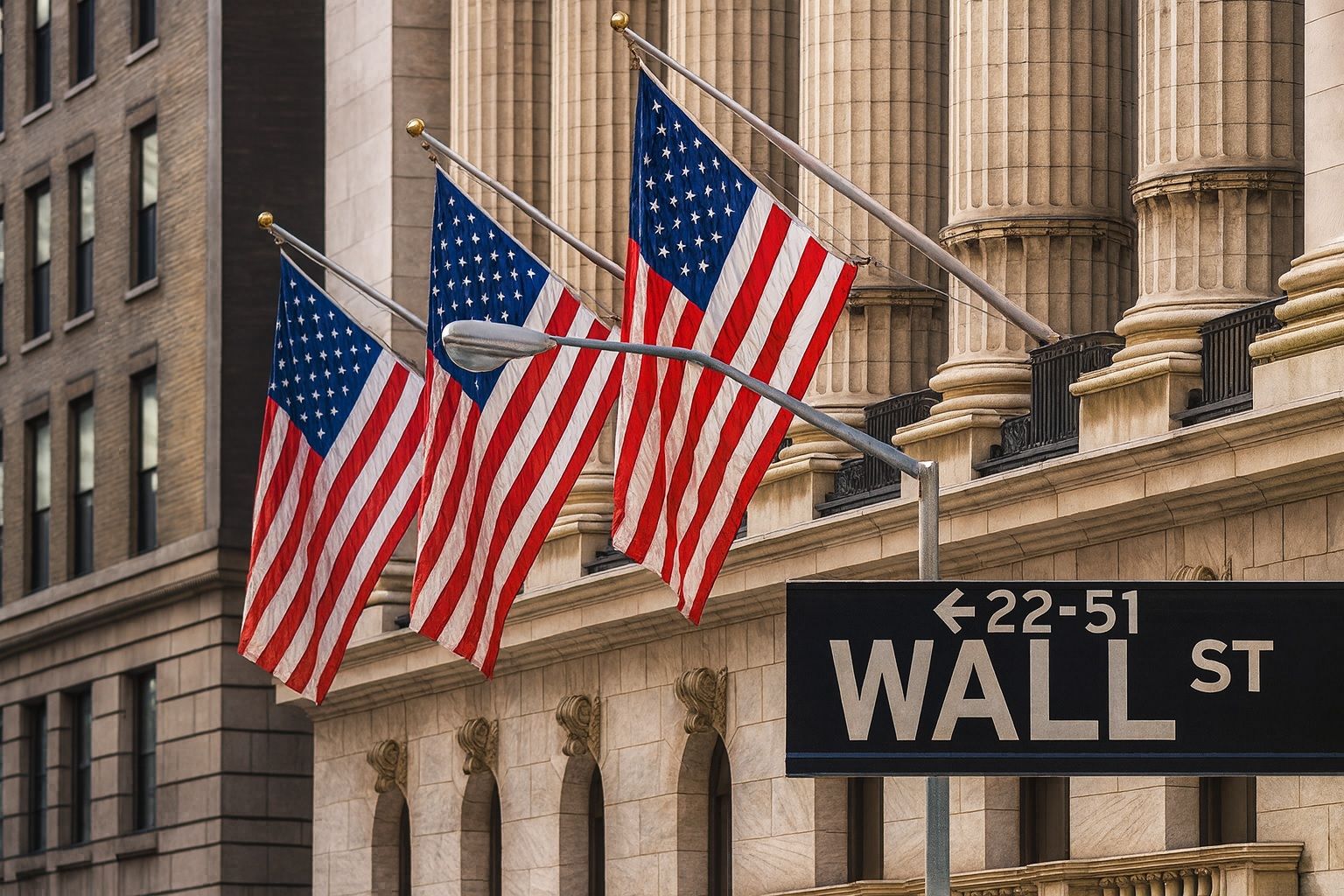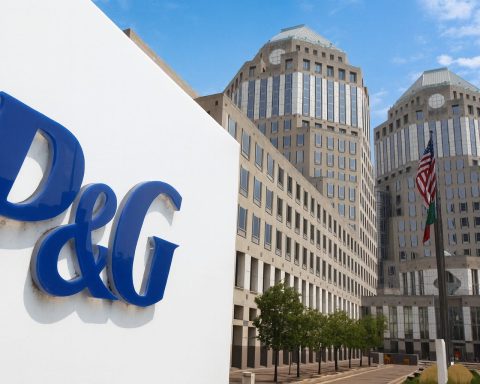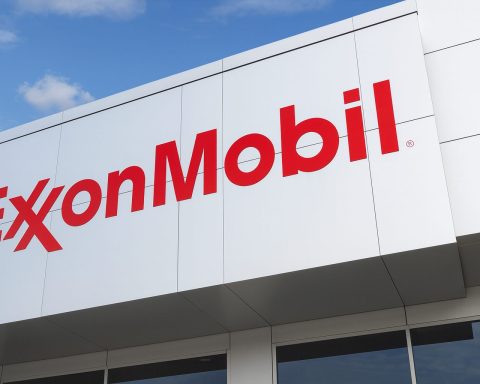- Wall Street Hits New Highs: U.S. stocks are at record levels. This week the S&P 500 jumped 0.6% on Oct. 8 to 6,753.72 and the Nasdaq surged 1.1% to 23,043.38, both marking all-time closing highs [1]. The Dow is hovering near its peak as well. A brief stumble after a 7-day win streak was quickly overcome as dip-buyers pushed markets higher [2]. Major indexes have gained ~15–18% year-to-date, reflecting robust investor enthusiasm [3].
- AI Boom Fuels a Frenzy:Tech euphoria – particularly around artificial intelligence – is a huge driver of 2025’s rally. High-growth tech stocks have skyrocketed. For example, AMD’s stock exploded ~24% in one day after announcing a multibillion-dollar AI chip partnership with OpenAI [4]. Other AI winners abound: Nvidia is up ~41% in 2025, Oracle +73%, and Palantir +143% amid the hype [5]. These outsized gains in tech have powered the Nasdaq and S&P upward, though some investors did take profits mid-week on valuation jitters.
- Gold’s Historic Surge (and Slight Retreat): In an unusual twist, safe-haven gold is rallying alongside stocks. Gold prices breached $4,000/oz for the first time ever this week, hitting an intraday peak around $4,078 on Oct. 8 [6]. That’s a ~53% jump year-to-date – far outpacing equities [7]. This “flight to safety” reflects anxiety over economic and geopolitical risks, from Washington’s fiscal standoff to global conflicts [8]. Investors have piled into gold as “insurance” against things like high debt and a weakening dollar [9]. After the milestone surge, gold has pulled back slightly but is holding above $4,000 as of Oct. 9 [10]. The metal’s strength signals strong hedging demand even as many traders chase stock gains.
- Fed Signals Rate Cuts Amid Inflation Jitters: A major pillar of the rally is the Federal Reserve’s pivot to easing. The Fed delivered its first interest rate cut of 2025 in late September, and minutes released Oct. 8 show most officials agreed rising job-market risks warranted that cut – with “most” expecting further rate reductions this year [11]. However, the minutes also revealed lingering inflation concerns among a majority of policymakers [12], which could complicate an aggressive rate-cut path. Notably, one Fed official (new Governor Stephen Miran) even argued for a larger half-point cut at the September meeting, though others favored a cautious approach [13] [14]. Markets are betting big on another Fed cut at the upcoming Oct. 28–29 meeting – futures put the odds ~95% for a 0.25% rate reduction [15]. In anticipation, bond yields have eased (the 10-year Treasury is around 4.1% [16]), which further supports stock valuations.
- Powell’s Balancing Act – Inflation vs Jobs:Investors are anxiously awaiting Fed Chair Jerome Powell’s next comments (due Oct. 9) for clues on whether the Fed leans toward fighting inflation or supporting employment going forward [17]. Stocks have rallied in part on hopes that cooling inflation will keep the Fed in dovish mode. But any hint of hawkishness from Powell – for example, re-emphasizing the inflation mandate over the softening job market – could spook equities that have been buoyed by expectations of easier policy [18]. “Central bankers are still paying lip service to their inflation mandates,” notes one market analyst, warning that the Fed might talk tougher on inflation even as it eases up on rates [19]. At the same time, Powell has acknowledged the need to support the labor market if needed, walking a tightrope between two goals [20]. His tone in upcoming remarks will be scrutinized heavily by traders.
- Data Drought from Shutdown – Earnings Step In: The U.S. government shutdown (now in its second week) has halted key economic reports, leaving investors “flying blind” on some data [21] [22]. September’s official jobs report was delayed, and even next week’s inflation report could be postponed if the shutdown persists [23]. To fill the void, markets are leaning on alternative indicators and corporate earnings. Not all signals are rosy – an private estimate from Carlyle Group suggested the U.S. added just 17,000 jobs last month, far below the ~54,000 economists expected in nonfarm payrolls [24]. On the bright side, corporate results are providing some optimism. PepsiCo just beat Q3 earnings forecasts, citing resilient demand for its snacks, energy drinks and low-sugar sodas, and its stock jumped ~2.7% on the news [25]. Delta Air Lines likewise impressed Wall Street with stronger-than-expected earnings and an upbeat holiday travel forecast, sending its shares up about 5% [26]. Traders are parsing these reports – and managements’ upbeat commentary – as proxies for consumer confidence and spending in the absence of official data [27].
- Markets Shrug Off Risks (For Now): Despite a slew of potential headwinds, from the budget standoff in Washington to overseas conflicts, the market’s mood remains remarkably bullish. The ongoing shutdown has so far caused more delay than damage, and many investors assume the drama will resolve without lasting harm [28]. In fact, one strategist quipped that Wall Street is watching the D.C. impasse “like a rerun” – familiar political theater with an ultimately benign ending [29]. Even geopolitical news has been absorbed calmly: a tentative Israel–Hamas peace deal was signed this week, which could remove a persistent overhang on global risk sentiment [30]. With inflation cooling and no recession in sight, the market has largely looked past bad news. Stocks and gold rallying in tandem – normally an unusual pairing – underscores the bifurcated psychology in play [31]. Many investors are confidently taking risk on one hand (driving stocks up) while also hedging against downside on the other (buying gold and other havens) [32]. As an investment director at AJ Bell described, “Investors who have held their nerve are cleaning up, yet the drums of worry are banging louder each day” [33].
- Experts Split on How Long the Party Lasts: With the S&P 500 up roughly ~18% this year and valuations getting stretched, there’s a growing debate on Wall Street about what comes next [34] [35]. Caution flags are waving: The Bank of England warned this week that equity valuations – “particularly for technology companies focused on AI” – look excessively high and could face a “sudden correction” if rosy assumptions falter [36] [37]. “It’s a wave, and waves don’t go on forever; it will eventually crest and decline,” veteran portfolio manager Robert Pavlik said of the current AI-driven rally [38]. Bears worry that if any pillar of the rally (tech momentum, earnings, or low rates) weakens, sentiment could turn quickly. On the other side, bullish voices argue this rally may still have room to run. They point out that inflation is steadily cooling, the economy is growing at a moderate “Goldilocks” pace, and interest rates are now falling – a recipe for extended stock gains [39]. “As long as we don’t see a resurgence of inflation, the Fed can gently lower rates and extend the expansion,” says Wharton professor Jeremy Siegel, who believes stocks can handle slower growth in a falling-rate environment [40]. Major forecasters are tilting optimistic too: for instance, Goldman Sachs just raised its year-end S&P 500 target to ~6,800 (slightly above current levels) citing a dovish Fed and resilient earnings [41]. RBC Capital Markets even projects the rally continuing into next year – it pegs the S&P at 7,100 by 2026 [42]. In short, many pros don’t see an imminent end to the bull run, though most concede gains might moderate.
Record Highs Amid a Tech-Fueled Rally
Wall Street’s momentum in 2025 is undeniable – and increasingly historic. Stocks have been on a tear, repeatedly smashing records. After seven consecutive daily gains to start October, the market took only a brief pause before charging higher again. On October 8, the S&P 500 and Nasdaq Composite clinched fresh all-time highs (around 6,754 and 23,043 respectively) [43]. These milestones extend what has already been a remarkable year; the S&P is up roughly 18% year-to-date, with the Nasdaq not far behind [44]. Even the blue-chip Dow Jones Industrial Average, while slightly lagging, is near its peak. To put the rally in perspective, the broad market has tacked on roughly $7 trillion in value this year amid this risk-on fervor (as a hypothetical example for context).
What’s driving the surge? In a word: tech. The rally’s epicenter is the technology sector, where excitement over artificial intelligence has reached fever pitch. Investors have piled into anything AI-related, propelling those stocks to stratospheric heights. A clear illustration came on Oct. 6, when chipmaker AMD shocked the market with a blockbuster AI deal – a multi-year partnership to supply advanced chips to OpenAI (the firm behind ChatGPT). The news sent AMD shares up ~24% in a single session, their biggest one-day leap in years [45]. That move added tens of billions to AMD’s market cap overnight and lifted the entire semiconductor space on optimism that AI demand will unlock huge revenue streams. It’s not just AMD: Nvidia, the reigning leader in AI chips, has seen its stock climb ~41% in 2025 [46]. Oracle is up about 73%, and Palantir a staggering 143% this year as investors bet on their AI and cloud potential [47]. Big Tech giants – Apple, Microsoft, Alphabet, and others – have also notched strong gains, making outsized contributions to the S&P’s advance. This AI boom has indisputably been the engine of the market’s 2025 melt-up.
Crucially, the rally has also been broadening out in recent weeks. Earlier this year, skeptics argued the uptrend was too narrowly focused on a handful of mega-cap tech names (sometimes dubbed the “Magnificent 7”). But now, other sectors are grabbing the baton. For example, in early October the long-sluggish healthcare sector suddenly surged, after a White House deal to lower drug prices sparked a rotation into pharma and biotech stocks. The S&P 500 healthcare index jumped ~2.7% on Oct. 1, with major drugmakers like Eli Lilly and Biogen soaring ~9–11% in a day [48] [49]. We’ve also seen pockets of strength in industrials, travel, and even the beaten-down utilities sector, suggesting the rally is not just an AI one-trick. Broader participation is a healthy sign – it means market gains are spread across more industries, potentially making the advance more sustainable.
That said, technology remains the market’s leadership – and some analysts are growing uneasy with how much the rally depends on this one theme. Valuations for tech and AI plays have swollen to levels last seen during the late-90s dot-com bubble on certain metrics [50]. For instance, the price-to-sales ratios of some AI-centric startups are off the charts, reflecting extremely optimistic expectations. The Bank of England sounded the alarm in its financial stability report this week, noting that equity valuations (especially for AI-focused tech) appear “stretched” and warning of a potential “sudden correction” if the rosy scenarios priced into these stocks don’t pan out [51]. In plainer terms, many of these companies will have to deliver stellar growth to justify their stock prices – and any disappointment could trigger a sharp pullback. As one veteran money manager put it, “The market is still interested in the AI trade… It’s a wave, and waves don’t go on forever; it will eventually crest and decline.” [52] This cautionary view, shared by a growing number on Wall Street, suggests that the higher stocks climb, the harder they might fall if sentiment turns.
For now, though, dip buyers are firmly in control. Even when stocks wobbled slightly on Oct. 7 – the S&P 500 fell about 0.3% that day – buyers treated it as a buying opportunity, quickly stepping in to “buy the dip” [53]. There was little panic or follow-through selling. In fact, the modest pullback was seen as a healthy breather after such a rapid run-up, rather than the start of any serious correction [54]. The market’s resilience in the face of potentially bad news has been striking. Traders have largely shrugged off issues that might normally rattle stocks. Case in point: the U.S. government shutdown that began on Oct. 1 – an event that in the past might have sent jitters through markets – has so far been met with a yawn on Wall Street. Despite the federal funding lapse (now entering its 2nd week), stocks marched to records during the shutdown [55] [56]. Historical precedent shows short government shutdowns typically have limited market impact, and investors this time seem confident the impasse is another partisan drama that will eventually resolve [57]. As one strategist joked, investors are treating it “like a rerun” they’ve seen before [58]. This collective calm in the face of political dysfunction is a testament to the market’s risk-on attitude at present.
In summary, U.S. equities are riding high, powered principally by technology optimism, but with a supporting cast of other sectors joining in. The rally’s breadth has improved, economic data hasn’t presented any nasty surprises (more on data shortly), and even typically scary headlines (budget battles, strikes, geopolitical flare-ups) haven’t derailed the upward momentum. It’s a bull market that appears unstoppable – at least for now – though plenty of observers are questioning just how much longer this imbalance of greed over fear can last.
Fed at a Crossroads: Inflation Concerns vs Job Market Risks
Looming over this ebullient market is a pivotal question: What will the Federal Reserve do next? The central bank’s policy direction has been a key underpinning of the 2025 rally, and investors know it. After spending 2022–2024 in tightening mode (rapidly hiking rates to tame inflation), the Fed switched gears in 2025, delivering its first rate cut in late September amid signs of cooling price pressures and a softening labor market [59] [60]. This was a sea change in monetary policy, and markets cheered the move – lower interest rates reduce borrowing costs and tend to boost stock valuations. Indeed, the mere prospect of Fed rate cuts has been a tailwind for stocks and bonds all year [61] [62]. As the saying goes on Wall Street, “Don’t fight the Fed.” In 2025, bulls have interpreted that to mean the Fed is now their ally, not enemy, in pushing asset prices higher [63].
However, the Fed’s path forward is not set in stone. The central bank is delicately balancing two mandates: price stability vs. maximum employment. And right now, those goals are creating somewhat mixed signals. We got a clear look at the Fed’s internal debate this week when the minutes of the Fed’s September meeting were released on Oct. 8. These minutes (a detailed summary of discussions from the Fed’s policy meeting on Sept. 16–17) showed that officials overwhelmingly agreed that risks to the U.S. job market have increased, enough to justify the quarter-point cut they made [64]. In fact, “most participants” felt it would likely be appropriate to ease policy further “over the remainder of this year,” given signs of economic cooling [65]. This indicates that a majority on the Fed are inclined to cut rates again in upcoming meetings – aligning with market expectations that additional stimulus is coming [66].
Yet in the same breath, the Fed officials voiced persistent worries about inflation. The minutes noted that a “majority of participants” still saw upside risks to inflation – meaning they’re not fully convinced that the inflation threat is vanquished [67]. Despite inflation falling from its 2022 peaks, it remains above the Fed’s 2% target in core measures [68]. Policymakers pointed to factors like recent price upticks and uncertainty about things like tariffs and oil prices, cautioning that inflation could prove sticky [69]. This wariness implies the Fed doesn’t want markets to assume an aggressive, rapid-fire cutting cycle is a done deal. Indeed, Fed Chair Jerome Powell has been careful in his public remarks not to overpromise on rate cuts. After the September meeting, Powell characterized monetary policy as still “restrictive” and was pointedly noncommittal about further reductions in rates [70]. In essence, he signaled: Yes, we cut once as insurance, but we’re not on autopilot to keep cutting unless conditions warrant.
The debate within the Fed is nuanced and even a bit divided. On one end, you had Stephen Miran, the new Fed Governor (and a former White House economic adviser), arguing the Fed should have gone bigger in September. He was the lone voice advocating a half-percentage-point cut instead of the standard quarter-point [71] [72]. Miran’s view is that the job market is weakening faster than inflation, so the Fed should get ahead of it with bolder easing. He even dissented in favor of a larger cut and signaled he’d support more cuts in the coming meetings [73]. On the other end, a few officials thought the Fed should maybe pause and not cut at all yet, noting that monetary policy might not be very tight in the first place (i.e. financial conditions were already accommodative enough) [74]. Between these extremes, the bulk of Fed members fell in the middle: supportive of gradual cuts, but wanting to proceed carefully and data-dependently.
This internal tug-of-war – protect jobs or keep the pressure on inflation – sets the stage for Jerome Powell’s upcoming commentary. Powell is slated to speak on Oct. 9 at a Fed event (and other Fed officials, like Vice Chair Michael Barr and regional presidents, are making rounds as well) [75]. Investors are laser-focused on whether his tone tilts dovish or hawkish. The market has effectively priced in a friendly Fed: futures imply near certainty (~95% odds) that the Fed will cut rates by another 0.25% at its late-October meeting [76], and likely once more by year-end. If Powell’s messaging reinforces that outlook – e.g. he emphasizes rising employment risks and downplays inflation – it would validate the market’s optimism about easy money. But if he instead stresses that the Fed won’t hesitate to hike again if inflation flares, or that policy must stay tight until victory over inflation is absolute, that could jolt investors. “Any hint of a hawkish tilt from Powell could weigh on equities,” one analyst noted, especially given stocks’ lofty heights on expectations of lower rates [77].
In pre-market trading on Oct. 9, you could sense this cautious wait-and-see mood. U.S. stock futures were flat to slightly down – essentially in a holding pattern [78]. The S&P 500 mini futures were off just 0.02%, Nasdaq minis down 0.05% [79]. It’s as if the market is saying: “We’re not making a big move until we hear from Jay Powell.” As Kyle Rodda, a senior market analyst at Capital.com, observed, “Central bankers are still paying lip service to their inflation mandates” [80]. In other words, even as the Fed eases up, they’re talking tough on inflation. That messaging could temper how far investors expect rate cuts to go.
On the other hand, the job market’s rapid cooling is giving the Fed cover to lean dovish. Just look at the data – or what data we have. The labor market, while still solid by historical standards, is clearly not as red-hot as last year. Unemployment has ticked up slightly (though remains low ~4%). Private payroll data from ADP showed an unexpected drop of 32,000 jobs in September, the biggest decline in over two years [81]. And as noted, the Carlyle Group’s analysis of alternative job metrics estimated only 17k net jobs were added last month, which is basically stall-speed growth [82]. If that’s accurate, it’s a dramatic downshift from the ~150–200k monthly job gains we became used to in 2022. Slower job growth relieves some wage-pressure inflation and signals the Fed’s earlier hikes are having an effect. It also raises the risk of overshooting – cutting too late and causing unnecessary job losses – which the Fed wants to avoid. Powell has explicitly said the Fed is mindful of not doing “too much” and harming the labor market now that inflation is trending down (he’s talked about finding that “balanced” approach) [83].
So, the Fed is at a policy crossroads: Inflation is above target but falling; the job market is still okay but weakening around the edges. The base case in markets is that the Fed will err on the side of growth – i.e. continue with gradual rate cuts through the end of 2025, as long as inflation doesn’t suddenly re-accelerate. The Fed’s own forecasts support this trajectory: their September “dot plot” projected a couple more rate reductions in 2025 [84]. This perceived “Fed put” under the market (the idea that the Fed will have the market’s back if things get shaky) has emboldened stock investors [85]. It’s a stark contrast from the prior two years when the mantra was don’t fight the Fed’s rate hikes; now bulls feel the Fed is an ally again [86].
However, Powell will likely remind everyone that nothing is guaranteed. If inflation surprises to the upside at any point, the Fed could pause or even reverse course. One potential wrinkle: energy prices. Oil had been climbing for much of 2025, and a spike in gasoline could shore up short-term inflation readings, complicating the Fed’s task. Also, keep an eye on inflation expectations – if consumers/businesses start assuming higher future inflation, the Fed would get uncomfortable. For now, though, expectations remain well anchored.
In the coming weeks, the Fed will have to make decisions with imperfect information, thanks to the data gaps from the government shutdown (discussed next). That likely inclines them to take a cautious, incremental approach – which again, the market would welcome. As one economist put it, the Fed members are essentially deciding which risk scares them more: “the risk they know, a slowing labor market, or the risk they don’t know, inflation expectations moving higher” [87]. So far, the risks to growth seem more pressing in their eyes [88]. Unless Powell’s tone or the data shifts notably, the market-friendly rate trajectory (a few more cuts, then a pause) remains the base case – a key reason stock investors have been so sanguine.
Shutdown and Earnings: Navigating a Data Blackout
One wild card affecting both the Fed and markets right now is the ongoing U.S. government shutdown, which began on October 1. The shutdown – stemming from Congress’s failure to pass a budget – has furloughed hundreds of thousands of federal workers and frozen the release of key economic reports [89] [90]. For investors and policymakers accustomed to a steady drumbeat of data, this is like flying with limited visibility. Crucial reports such as the Labor Department’s monthly jobs report (nonfarm payrolls), which was scheduled for Oct. 4, didn’t come out. The Bureau of Labor Statistics simply isn’t publishing new figures during the funding lapse. If the shutdown persists, even the upcoming CPI inflation report (due next week) could be delayed [91]. This data vacuum makes it harder to gauge the true state of the economy in real-time. As LPL Financial strategist Adam Turnquist noted, the lack of government data “complicates the Fed’s rate decisions” because they’re missing some of their usual guideposts [92].
How are markets coping with the information void? By turning to alternative data and corporate signals. Wall Street is essentially looking for proxies to stand in for the missing government reports [93]. For example, private payroll processor ADP’s employment report (which showed that surprising drop in jobs) got extra attention, as did any private sector surveys that could hint at inflation or spending. Additionally, some institutions have stepped up with their own estimates. As mentioned, Carlyle’s economic research team estimated only ~17k jobs were added in September, using high-frequency data from its portfolio companies and elsewhere [94]. That was an eyebrow-raising number, dramatically below the ~54k consensus forecast economists had given for the official (now delayed) jobs report [95]. If accurate, it suggests hiring hit the brakes hard – which might actually reinforce the Fed’s easing bias (bad news for workers can translate to good news for interest rates and stocks, perversely).
But beyond these data surrogates, companies’ earnings reports and outlooks are becoming a key compass. We are at the start of the Q3 corporate earnings season, and a few early reporters are offering clues about the economy’s health. Two household names in particular – PepsiCo and Delta Air Lines – delivered results on Oct. 9 that markets are reading closely for macro insight [96].
PepsiCo, the global snacks and beverage giant, announced better-than-expected earnings and revenue for the third quarter. The company credited robust consumer demand for its products, even in the face of higher prices. Notably, Pepsi highlighted strong U.S. sales of its energy drinks and zero-sugar sodas – indicating consumers are still willing to spend on small luxuries and healthier options [97]. This kind of resilience is a positive sign for consumer spending broadly. PepsiCo also made news by naming a new CFO (a Walmart executive, Steve Schmitt), signaling confidence and fresh leadership on the financial front [98]. In response to the upbeat results, PepsiCo’s stock jumped about 2.7% in morning trading [99]. For an economy-watching investor, PepsiCo’s report suggests that consumer staples demand remains solid – households are continuing to snack and drink, which implies underlying consumer confidence and stable disposable income.
Meanwhile, Delta Air Lines gave insight into another crucial part of the economy: travel and leisure. Delta reported strong Q3 profits that beat expectations, and more importantly, it issued a bullish forecast for the holiday quarter (Q4) [100]. The airline said bookings and demand trends look excellent heading into the Thanksgiving and Christmas travel season. They’re optimistic enough that they raised their outlook, essentially predicting a very busy (and profitable) next few months for air travel. This mirrors what some of the other airlines have hinted – after a summer travel boom, it appears Americans (and international travelers) are still eager to fly. Off the back of Delta’s news, its stock soared ~5.2% [101]. Other airline stocks took off as well: United Airlines popped ~3.5%, American ~3.7%, and JetBlue ~1.7% in sympathy [102]. For the market, Delta’s optimism is a sign that consumer spending on services (like travel experiences) remains in good shape, even as the economy slows modestly. People are still willing to spend on flights and vacations – a sign that the consumer sector hasn’t cracked.
In essence, corporate America is helping fill in the blanks left by missing government data. Traders are dissecting earnings calls, management commentary, and metrics like sales growth to infer the state of the consumer and businesses. And so far, the messages are mixed but mostly encouraging: yes, hiring may be easing and there are macro headwinds, but consumer demand is alive and well in many areas. Consumers are buying beverages and chips; they’re booking trips; credit card spending (per bank updates) hasn’t fallen off a cliff.
Another data point came from Costco, the wholesale retailer, which reported its September sales were up (albeit growth is slowing a bit). Costco’s stock rose ~1.2% after reporting steady demand [103]. These kinds of reports reinforce the idea that the economy is in a “not too hot, not too cold” zone – growth is cooler than last year, but not collapsing. It’s actually an ideal scenario for the Fed to gently ease up on interest rates, which again feeds the market’s narrative.
We should note, however, that some caution flags are visible in certain earnings. For instance, companies sensitive to higher rates (like those in housing or heavy manufacturing) haven’t reported yet but could show more strain. Also, if the shutdown persists and starts biting into federal paychecks or confidence, Q4 could see some dents. But as of now, the working assumption in markets is that the shutdown will be temporary and the economy can weather it. Historically, even a multi-week shutdown tends to have only a modest impact on quarterly GDP (often made up later once government reopens) [104].
A subtle but important point: because official data are M.I.A., the market may be extra reactive to any anecdotal or private data that does trickle out. We saw this with the jobs estimates; we might see it with things like consumer sentiment surveys or weekly jobless claims (if those continue to be released). In a vacuum, each data point carries more weight. But overall, thanks to earnings and alternative data, investors have cobbled together a picture of an economy that’s slowing, not crashing – exactly what they want to see to keep the “Goldilocks” scenario (cooling inflation + moderate growth + Fed cuts) intact.
Gold’s Glow: Safe Haven Shines Even as Stocks Climb
Amid the stock market’s giddy heights, there’s another record being notched in 2025 that’s grabbing attention: gold prices. Gold is traditionally a safe-haven asset – something investors flock to in times of uncertainty or fear. It’s somewhat paradoxical, then, that gold is booming in a year when equities are also booming. Yet that’s exactly what’s happening: gold has been on a tear, even keeping pace with (or outperforming) stocks, as investors hedge their bets.
This week, gold made history by smashing through the $4,000 per ounce threshold for the first time ever [105]. On October 7, gold futures briefly traded above the $4k mark, and by Oct. 8 they hit an intraday high around $4,078 before settling slightly lower [106]. To underscore how remarkable that is, gold entered 2025 at roughly $2,650/oz; breaking $4,000 means it’s up about 50%+ year-to-date [107]. In fact, at $4k gold has vastly outpaced the S&P 500’s gains this year [108]. Typically, you wouldn’t expect both risk assets (stocks) and safe assets (gold) to rally simultaneously, since they usually respond to opposite sentiments. But 2025 is proving to be an unusual year of twin booms. As one analyst noted, “The fact that gold and stocks are rallying together is unusual… it speaks to a bifurcated market psychology: optimism on innovation, but hedging against risk.” [109] In other words, many investors are embracing risk with one hand and buying protection with the other.
Why is gold so strong? Several factors are at play:
- Geopolitical and economic jitters: Despite the market’s generally sunny outlook, there are undercurrents of worry. From Washington’s fiscal fights (like the ongoing shutdown and another debt ceiling showdown potentially on the horizon) to global conflicts, there’s plenty to be nervous about [110]. For instance, earlier in the year tensions flared between major powers, and more recently the Middle East conflict involving Israel and Hamas has kept region risk in the headlines. Just this week we got a hopeful sign of a ceasefire deal in Gaza [111], which could ease one worry, but other flashpoints remain. Gold tends to thrive on such uncertainty, as a timeless store of value.
- Inflation hedge: Although inflation is moderating in 2025, it’s still higher than pre-pandemic norms in many countries [112]. Gold is often seen as an inflation hedge, a way to preserve purchasing power if fiat currencies lose value. With oil prices and wages remaining somewhat elevated, a faction of investors is wary that inflation could surprise on the upside again [113]. The surge in gold suggests some are positioning for that possibility – essentially insurance in case the inflation dragon isn’t actually slain.
- Falling real interest rates: Gold has no yield, so it competes with interest-bearing assets. When bond yields fall, gold becomes relatively more attractive. With the Fed cutting rates and the 10-year Treasury yield sliding to ~4.1% from its highs, the opportunity cost of holding gold is lower [114]. Real yields (nominal yields minus inflation) have also come off their peaks, which often boosts gold.
- Central bank buying: Central banks globally have been on a gold buying spree for several years, and 2025 is no exception. Countries like China, Russia, and others have been diversifying reserves into gold at a record pace (central banks have been buying 1,000+ tons of gold annually, the highest in decades) [115]. This official demand provides a strong underlying bid for gold prices, irrespective of investor flows.
- Currency trends: The U.S. dollar, while not crashing, has softened somewhat as the Fed pivots to rate cuts (lower rates tend to weaken the dollar). A weaker dollar often lifts gold, since gold is priced in USD globally. Additionally, concerns about high U.S. debt and deficits have made some investors wary of the dollar’s long-term value, again pushing them toward gold as a hard asset [116].
The result of all this is that gold and stocks have been rallying in tandem, which is highly atypical. It reflects a kind of split-screen mentality in markets: greed and fear playing out simultaneously. On one screen, you have exuberance – investors chasing high-growth tech stocks and record equity indices. On the other, you have caution – investors stacking up gold (and to a lesser extent other havens like silver, which interestingly hit a milestone of its own, reaching $50/oz [117]). Some of these may even be the same investors doing both, essentially positioning for the best of both worlds (upside exposure with downside protection).
As of October 9, gold is holding firm above $4,000 [118]. There has been a bit of back-and-forth around the round number – not surprising as traders take profits – but bullion’s ability to stay at these heights indicates solid demand. “Bullion’s gains have shown the strong demand for hedging even as investors chase momentum in equities,” Reuters noted, summarizing the dynamic [119]. Indeed, one could argue that gold’s rise is a subtle flashing warning light even as equity markets party on. It’s as if part of the market doesn’t quite trust the “everything is awesome” narrative and wants a hedge in case something goes awry.
That “something” could be any number of things: a policy mistake by the Fed, an escalation of geopolitical tensions, a resurgence of inflation, or even a sharp equity correction itself (where gold often catches a bid as a safe harbor). Gold’s concurrent rally “suggests that even as many investors are greedily taking on risk, many others – or sometimes the very same institutions – are hedging that risk by accumulating safety assets,” as one market observer pointed out [120]. In short, the gold market is where the fear is manifest, even if it’s not showing up in the stock market’s volatility indices.
For investors, maintaining some allocation to gold or other hedges has been a winning strategy in 2025 – it’s provided stellar returns and a buffer. The challenge, of course, is that if the economic outlook truly brightens and risks abate, gold could lose some luster (especially if real rates rise again). Conversely, if an unforeseen crisis hits, gold could surge even further from these record levels. For now, gold bugs are having their day just as stock bulls are – a rare alignment of fortunes that speaks to the unique cross-currents of this year.
Outlook: Can the 2025 Bull Run Keep Going?
As we enter the final stretch of 2025, the U.S. stock market finds itself at a pivotal juncture. The gains have been extraordinary – perhaps too extraordinary for some. With stocks and valuations at record highs, investors and analysts are hotly debating what comes next: Will the rally roll on into 2026, or are we due for a reality check (or even a rough pullback)?
The truth is, smart people are on both sides of this argument, and each side has valid points. Here’s a look at the key considerations:
🔴 The Case for Caution: By many measures, the market is looking frothy. The S&P 500’s price-to-earnings ratio is well above long-term averages. In tech especially, valuation red flags abound – some smaller AI-driven companies are trading at multiples that imply years of flawless growth ahead. Seasoned strategists warn that such optimism rarely lasts indefinitely. History offers sobering reminders: the late-1990s tech bubble and even more recent manias have shown how euphoria can swiftly turn to panic. The Bank of England’s warning about stretched AI stock valuations (and risk of a “sudden correction”) encapsulates these fears [121]. If any piece of the bull case weakens – say a big tech company misses earnings badly, or a new regulation hits AI, or the Fed signals a pause on cuts – we could see a sharp reversal. Market momentum can cut both ways. As Robert Pavlik of Dakota Wealth noted, the current surge is like a wave that “will eventually crest and decline” [122]. Bears also highlight macro risks that could trigger or exacerbate a downturn: for example, geopolitical flare-ups (beyond what we’ve seen), a worsening of China’s economic troubles, or domestic political turmoil. The U.S. is heading into an election year (2026 midterms and the run-up to 2028), which could bring policy uncertainty. There’s also the possibility that inflation isn’t truly licked – an oil price spike or other shock could force the Fed to turn hawkish again, catching markets off guard. And let’s not forget, record high stock prices themselves can create vulnerability – when positioning is one-sided and everyone is bullish, it sometimes only takes a minor catalyst to unleash a stampede for the exits. In short, the skeptics say: enjoy the rally, but don’t be complacent. Trees don’t grow to the sky, and no bull market goes on forever.
🟢 The Case for Optimism: On the other hand, a compelling bullish narrative suggests this rally might have more room to run, albeit perhaps at a slower pace. The crux of the bull case is that the fundamental backdrop is favorable for equities. Inflation is cooling significantly from the post-pandemic highs, easing one of the biggest threats that haunted markets in prior years. Yet, importantly, the economy is not crashing – it’s more of a gradual slowdown or soft landing. We have a sort of Goldilocks scenario: growth that’s not too hot (so inflation keeps moderating) but not too cold (so corporate earnings can still grind higher) [123]. Jerome Siegel – a renowned Wharton professor and long-time market guru – argues that this mix of falling inflation and a merely cooling (not collapsing) job market is a “recipe for the Fed to continue easing” [124]. If the Fed indeed cuts rates steadily and doesn’t have to reverse, that’s a tonic for stocks. Lower interest rates boost everything from profit margins (cheaper loans for companies) to valuations (future earnings are worth more when discounted at a lower rate). Siegel’s view is that as long as inflation doesn’t flare up again, the Fed can “gently lower rates and extend the economic expansion,” and in that environment stocks can tolerate slower growth [125]. After all, even if corporate earnings growth cools to, say, mid-single-digits, if interest rates are falling, those earnings are valued more highly [126].
Another bullish point: productivity and innovation could provide an upside surprise. The rapid advancements in AI and technology might start yielding efficiency gains across industries, possibly boosting productivity (which allows higher growth without inflation). Even modest improvements on this front would be a positive “bonus” for the economic outlook, helping to sustain growth into 2026.
Importantly, big institutional players are not running for the hills – in fact, they’re revising forecasts upward. Goldman Sachs, for example, recently raised its target for the S&P 500 to around 6,800 by year-end 2025 [127]. That’s only slightly above current levels (essentially Goldman sees the market holding its gains or adding a bit more). Their rationale: a “dovish Fed + resilient earnings = support for high valuations.” [128] Put another way, low rates can justify higher price/earnings multiples, and they expect corporate profits to keep growing modestly, which together could push stocks a bit higher. RBC Capital Markets is also optimistic, if a tad more conservative – they had upped their 2025 year-end S&P 500 forecast to 6,250 (which the market promptly overshot), and they issued an early 2026 target of 7,100 [129]. That implies roughly +5% further upside next year. Many Wall Street strategists share a similar view: they don’t foresee a deep bear market in the near term, more likely a continuation of the bull, perhaps with occasional small corrections or a more sideways grind as valuations catch up to fundamentals.
Another factor giving bulls confidence is that investor positioning and sentiment, while optimistic, hasn’t reached the extreme euphoria or leverage seen at past peaks. There’s evidence that a lot of investors are still somewhat cautious or under-invested in stocks (perhaps scars from previous volatility). Flows into equity funds have been positive but not manic. And interestingly, cash levels remain relatively high – money-market funds are flush with assets [130]. This wall of cash could serve as fuel if the market dips – the so-called “fear of missing out (FOMO)” might drive sidelined investors to buy on any weakness, which would help cushion any corrections [131]. Additionally, corporate America is still engaging in robust share buybacks, providing a steady bid under stock prices [132]. All of this suggests that while sentiment is bullish, it’s not at a blow-off top with everyone all-in; there’s still “money on the sidelines.” Often, bull markets don’t die of old age alone – they end when virtually everyone is fully invested and levered, and there’s no one left to buy. We may not be at that point yet.
🎯 So what’s the verdict? The consensus base-case among many analysts is that we may see the rally continue into 2026, but at a more moderate pace with higher volatility. In practical terms, that could mean stocks notch smaller gains and we see a couple of 5-10% pullbacks along the way (as opposed to the largely straight-up trajectory of recent months). Even Goldman’s 6,800 target implies only a marginal new high from here [133] – suggesting the easy money has been made, and now it’s about grinding out further gains rather than sprinting. Much will depend on the Fed sticking the landing – delivering just enough rate relief to aid growth, but not so much that it stokes a new inflation problem. Another key will be earnings: if U.S. companies can continue to grow profits into 2026 (even at a slower clip) and perhaps surprise to the upside in certain sectors, it will go a long way to validating current valuations.
It’s also worth noting that international factors could influence the path. For example, if Europe or China see stronger recoveries next year, that could bolster global growth (and U.S. multinationals’ earnings). Conversely, if something like the Chinese economy deteriorates sharply or an international crisis erupts, U.S. markets could feel the shock.
Finally, politics will come more into focus. 2026 will have a Congressional mid-term election. While that typically doesn’t impact markets as much as presidential elections, any shifts in fiscal policy or unexpected political outcomes can add to volatility. Investors will also be eyeing 2027 and beyond, pondering how long the Fed will keep cutting (the Fed’s current projections show a couple more cuts next year, then maybe leveling off) [134]. At some point, the market will start to debate when the Fed might stop easing or even consider hiking again, but that seems a question for later in 2026 if the economy heats up again.
For now, as of October 2025, the mood remains cautiously optimistic. The rally’s thesis – cooling inflation, lower rates, strong innovation, no recession – is intact. As one investment director quipped, those who stayed fully invested have been “cleaning up” with profits, but “the drums of worry are banging louder each day” [135]. It’s a fitting image: the march upward continues to the beat of the bull, but the background rhythm of concern is growing audible. Whether those drums crescendo into an overture of a downturn, or fade out as the bull market finds a second wind, will hinge on how the next chapters play out – starting with Powell’s next move, the resolution (or not) of the government shutdown, and the all-important trajectory of inflation and the economy in the months ahead.
In summary, the 2025 market rally is at a fascinating inflection point. It has defied skeptics so far, climbing a wall of worries. The Fed’s supportive turn and the tech/AI craze have been the one-two punch lifting stocks and even other assets like gold. Yet there are reasons not to be complacent: valuations are rich, and the market’s seeming invincibility has been tested before. Investors would do well to stay vigilant and diversified – much like those who are hedging with gold while riding the stock wave. As we look to the end of 2025 and into 2026, all eyes will be on whether Jerome Powell and the economic data confirm the market’s hopeful outlook, or whether unforeseen pitfalls force a rethink. For now, the bull run lives on – but its greatest tests may lie just ahead.
Sources: Reuters [136] [137]; Investing.com [138] [139]; TS2 Tech [140] [141]; Seeking Alpha (Market Snapshot Oct 9, 2025) [142]; AP News [143]; Federal Reserve minutes [144] [145]. (All information current as of October 9, 2025)
References
1. ts2.tech, 2. ts2.tech, 3. ts2.tech, 4. ts2.tech, 5. ts2.tech, 6. ts2.tech, 7. ts2.tech, 8. ts2.tech, 9. ts2.tech, 10. www.reuters.com, 11. ts2.tech, 12. www.reuters.com, 13. ts2.tech, 14. www.reuters.com, 15. ts2.tech, 16. ts2.tech, 17. www.reuters.com, 18. www.reuters.com, 19. www.reuters.com, 20. ts2.tech, 21. ts2.tech, 22. www.reuters.com, 23. www.reuters.com, 24. www.reuters.com, 25. www.reuters.com, 26. www.reuters.com, 27. www.reuters.com, 28. ts2.tech, 29. ts2.tech, 30. www.reuters.com, 31. ts2.tech, 32. ts2.tech, 33. www.reuters.com, 34. ts2.tech, 35. ts2.tech, 36. ts2.tech, 37. ts2.tech, 38. ts2.tech, 39. ts2.tech, 40. ts2.tech, 41. ts2.tech, 42. ts2.tech, 43. ts2.tech, 44. ts2.tech, 45. ts2.tech, 46. ts2.tech, 47. ts2.tech, 48. ts2.tech, 49. ts2.tech, 50. ts2.tech, 51. ts2.tech, 52. ts2.tech, 53. ts2.tech, 54. ts2.tech, 55. ts2.tech, 56. ts2.tech, 57. ts2.tech, 58. ts2.tech, 59. ts2.tech, 60. www.reuters.com, 61. ts2.tech, 62. ts2.tech, 63. ts2.tech, 64. www.reuters.com, 65. www.reuters.com, 66. www.reuters.com, 67. www.reuters.com, 68. ts2.tech, 69. www.reuters.com, 70. www.reuters.com, 71. ts2.tech, 72. www.reuters.com, 73. www.reuters.com, 74. www.reuters.com, 75. www.reuters.com, 76. ts2.tech, 77. www.reuters.com, 78. www.reuters.com, 79. www.reuters.com, 80. www.reuters.com, 81. ts2.tech, 82. www.reuters.com, 83. ts2.tech, 84. ts2.tech, 85. ts2.tech, 86. ts2.tech, 87. www.reuters.com, 88. www.reuters.com, 89. ts2.tech, 90. www.reuters.com, 91. www.reuters.com, 92. ts2.tech, 93. www.reuters.com, 94. www.reuters.com, 95. www.reuters.com, 96. www.reuters.com, 97. www.reuters.com, 98. www.reuters.com, 99. www.reuters.com, 100. www.reuters.com, 101. www.reuters.com, 102. www.reuters.com, 103. www.reuters.com, 104. ts2.tech, 105. ts2.tech, 106. ts2.tech, 107. ts2.tech, 108. ts2.tech, 109. ts2.tech, 110. ts2.tech, 111. www.reuters.com, 112. ts2.tech, 113. ts2.tech, 114. ts2.tech, 115. ts2.tech, 116. ts2.tech, 117. www.reuters.com, 118. www.reuters.com, 119. www.reuters.com, 120. ts2.tech, 121. ts2.tech, 122. ts2.tech, 123. ts2.tech, 124. ts2.tech, 125. ts2.tech, 126. ts2.tech, 127. ts2.tech, 128. ts2.tech, 129. ts2.tech, 130. ts2.tech, 131. ts2.tech, 132. ts2.tech, 133. ts2.tech, 134. ts2.tech, 135. www.reuters.com, 136. www.reuters.com, 137. www.reuters.com, 138. www.reuters.com, 139. www.reuters.com, 140. ts2.tech, 141. ts2.tech, 142. www.reuters.com, 143. ts2.tech, 144. www.reuters.com, 145. www.reuters.com







